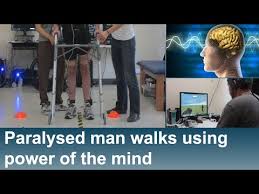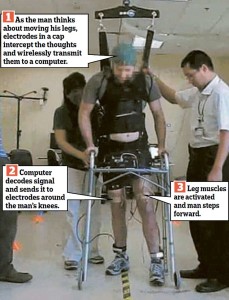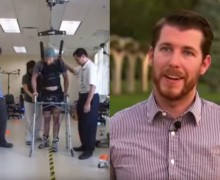Paralyzed Man Walks Using Brain Power – A Well Thought Out Scream By James Riordan

Most times the only news we hear is bad. It’s sad or terrifying and makes us wonder how the world will survive. But sometimes, something really good happens and when we hear about it we feel a surge of hope inside. So now comes the story of how scientists helped a patient use the power of his mind to overcome complete paralysis in both legs and learn to walk again. And this astonishing feat didn’t involve the help of an exoskeleton or robotic limbs, and no brain implants were required, making this a first for rehabilitation.
The patient was a 26-year-old man who had no motor (movement) function in his lower limbs due to a spinal cord injury sustained five years ago. He also lost sensation below his injury, although he could just about feel when his bladder was full.
Describing the results in the Journal of Neuroengineering and Rehabilitation, the team’s goal was to allow him to regain voluntary control of his legs using his brain, but without the need for invasive brain surgery. To achieve this, the researchers created a brain-computer interface system using an electroencephalogram (EEG) cap to read patterns of brain activity while he thought about walking.
Next, he underwent training to learn how to acquire brain control of an avatar’s walking within a virtual reality environment. Once he achieved this, he then had to build up strength in his leg muscles that had deteriorated through a lack of use, which involved electrical stimulation combined with weight shifting maneuvers.
After his muscles were reconditioned enough to stand, it was time for the really hard work to begin. Instead of going for gold straight away, the team first got him to practice walking movements while he was suspended a few centimeters off the ground. As he thought about walking, his brain signals (read by the EEG cap) bypassed his damaged spinal cord and were pinged to electrodes that had been positioned around his knees, providing muscular stimulation. Nineteen sessions later, the man had improved so much that he was ready to put his feet to the ground.
Wearing a system that supported his weight and helped prevent falls, he was able to successfully translate what he had learned and walked unsuspended. Over time, his control improved and he was able to walk several meters.
An undeniably incredible feat, but whether or not such a system could ultimately offer benefits to the wider population will rest on future trials involving more people. Obviously everyone is different, as are their injuries, but it is hoped that this technology could benefit many people. However, it might not be suitable in some circumstances.
“It can be speculated that a very severe traumatic brain injury in tandem with a spinal cord injury could prevent this brain-computer interface system from working,” An Do, one of the study’s lead researchers, told IFLScience.
There is also, as always, room for improvement, with the technology requiring tweaking and streamlining, which Do predicts will take a significant amount of time. Do also said that the team is working towards developing a simplified version as well as a system that would involve a brain implant, which could potentially offer improved control.








No Comment